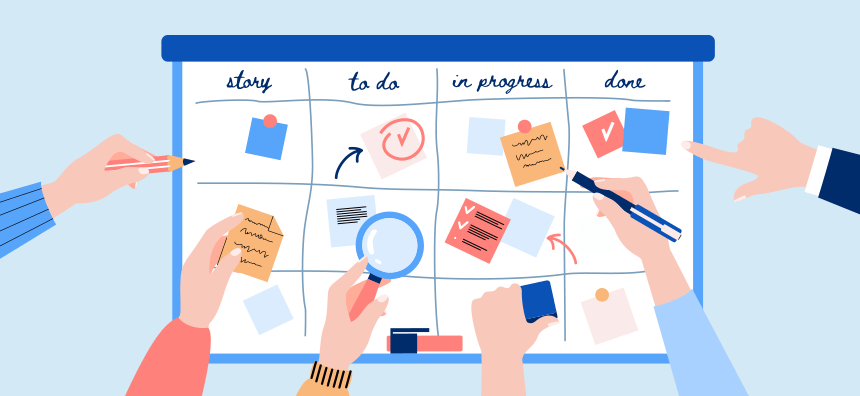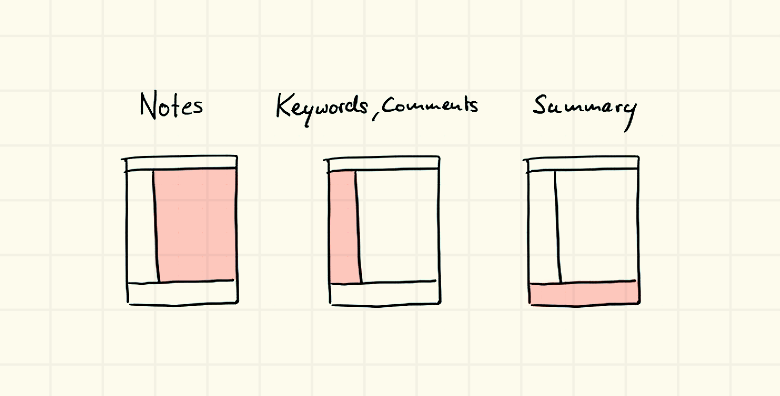
Click the button to start reading
Take Meeting Notes That Are Actually Useful
Just when you thought that your note taking days were over when you finished school, you enter the real world and realize that note taking is a critical and important skill in the workplace. Like any skill, you can become a better note taker with a little bit of practice and a couple great tips.
It is no secret that you need to be quick to capture important information in the heat of a meeting but writing what is said word for word isn’t going to cut it, it will leave you behind and confused. Developing a system for note taking will not only help you more accurately capture the essence of the meeting, but it will allow you to follow up more effectively in your role after the event.
All of this begs the question – how do you take notes that will actually be useful to you?

Why Should You Take Notes?
Taking notes has a number of benefits. Some of the most productive and successful people admit to having a clear and consistent way that they gather and store information. Notes are taken in order to capture key ideas and actions as well as keep records for reference.
Here are 4 reasons why you should learn how to take great notes.
1. Note Taking Helps You Retain Information
There are studies that prove we remember things better when we have physically written them down. While apps and laptops are great tools to take notes and there is the added convenience of digital file shareability, your brain is hardwired to prefer pen and paper. The tactile nature of writing engages your body which activates a different part of your brain, enforcing the natural learning process.
Do you remember what you had for breakfast 2 weeks ago? Probably not but if you had a meal plan, you could look back and know exactly what you ate. The same concept applies to a good set of notes. Who attended the meeting? What were the main items discussed? A quick glance and this information will start to come back to you as you are reminded of meeting highlights.
2. Note Taking is a Practice in Accountability
In large teams especially, it is easy to pass the ball and even the blame to someone else. If your meeting had a good note taker (or you are that good note taker), there is a record of who committed to what. This record keeps everyone on task and accountable for their actions. If you are taking notes for yourself, noting specific directives and expected outcomes will serve to keep you accountable and on track in your own work.
Plainly put, taking notes also ensures that you are paying attention. Rarely are meetings truly exciting and engaging, sometimes they are just necessary and there is a need to force yourself to pay attention. Taking notes is a productive way to ensure that you participate, even if it is in the form of a couple jotted down lines.
Committing to sharing notes with your team is also an act of accountability. If you know that your notes will be viewed by others, it is easier to spend more time ensuring that they are worth reading. Bonus? You may earn yourself some brownie points for a job well done and demonstrate impressive skills to your higher ups.
3. Note Taking Helps You Prioritize
Meetings are great for helping you paint a picture of the progress or status of a project and better understand your specific roles within it. As you take notes, remind yourself of the purpose of the meeting but also your purpose in the meeting. What role do you play? Maybe your role is that of expertise or perhaps you are a designer soliciting feedback. Ensure that your own notes serve your goals and will be useful to you after the meeting is over.
If the meeting is regarding a project with a clear timeline, you can use your notes to plan your progress along the way. This planning often comes after the meeting and as you are reviewing the content of your notes. If you have done a good job, you will be able to pull your actionables and prioritize them accordingly.
4. Note Taking Provides Important Records
Think of notes as a professional alibi. Meeting notes serve as a record of important decisions or tasks and are the first place you should look if you are seeking clarity on something that happened at the meeting.
The ultimate example of notes as records are formal minutes from board meetings. There are legal obligations to record board motions as well as voting records of individual directors. This holds boards accountable to their membership or shareholders and keeps detailed records of decisions and actions that guide the rest of the organization.

Effective Meetings For Note Taking
You can’t take great notes at disorganized meetings… you can certainly try but it will be an uphill climb. Having an organized meeting with a clear purpose and written agenda is a great start but it may not always be in your control. If it is within your control or you have the ear of the meeting facilitator, push for the creation of a standard agenda if one doesn’t already exist. Agendas make a great template for note taking.
For our purposes, let’s assume that agendas are provided at every meeting. First, you then need to understand why you are having a meeting in the first place. Understanding the why will help you know how to take notes that make sense and will be useful to you after the fact.
When it comes to taking great notes, understanding the type of meeting will be helpful. There are several types of meeting that you may be familiar with:
Status Update/Check in
These meetings are usually intended to provide the team or client with a progress update of a specific project. They are generally informative in nature though it isn’t unusual to finish the meeting with new directives and tasks moving forward. While programs (like Teamly) have virtually eliminated the need for in person or scheduled updates, it is still nice to touch base on a regular basis to keep everyone on track.
Decision Meeting
Sometimes, there will need to be a meeting called in order to make an important decision as it relates to your team or a project. This could be as small as choosing a photographer for the team headshots or as large as choosing the perfect venue for a conference. Either way, the outcome will be a final decision. Decision type meetings usually have some kind of take away or delegate responsibilities for implementation or follow up.

Brainstorming and Innovation
Nothing beats a great brainstorming session! These meetings are often full of ideas and generally involve both long and short term visions and tasks to be considered. When you put a bunch of creative and innovative people in a room and foster an environment where they feel comfortable hashing out ideas, magic happens!
Team building and Connection
Nowadays, many teams are working remotely at least some of the time. This model certainly has benefits but we are social beings and connection is important for developing relationships. Connecting with your team builds trust among members and has been shown to produce better work related (and non work related) outcomes. In person or not, these types of meetings have the intention of building understanding, camaraderie, and cohesion among members.
Each of these meetings have a different purpose so it would make sense that the notes that you would take at each of these gatherings would vary. When you are clear on a purpose, you can better tailor your notes to capture the most important and relevant information.
A good example may be using some kind of recording or transcription service like Zoom or Otter AI for brainstorming type meetings. This will allow you to catch every single idea while still fully participating. You can and should still jot down notes because there is value in that physical motion but you can rest easy knowing that every detail will be captured. It is helpful to look (or listen) back on these meetings as you may have missed a great idea or decide to hash one out in more detail later.
Another example would be a board of directors meeting. These meetings tend to combine information with opportunities to make strategic decisions. When it comes to taking notes for a board, your note taking skills will be put to the test. There are a number of ways to properly take these kinds of minutes and you may want to refer to Robert’s Rules as there are legalities to consider.

Note Taking Foundations
While there are a million templates for note taking, the majority of them have a number of things in common that make them great and useful. No matter what type of meeting you are attending, there are several foundation components that find their way into any useful set of notes.
Start with an Agenda
Remember how good notes can only be taken at good meetings? An agenda outlines the progression of a meeting and is an excellent place to start for notes. If you are taking digital notes, copy and paste the agenda into a document so that you can easily add notes under the appropriate agenda item. You can even add a simple table with labeled sections such as noting who the presenter was, linking any relevant document or resource that was shared or references, and noting any assignments that come out of that section. You may also find it helpful to jot down the time which was spent on each item.
Note Attendees
Keeping track of who attended the meeting is a very helpful habit for every notetaker. This provides context for the meeting such an understanding of what departments were involved or outside council that may have been consulted. It is also a great way to ensure that people are accountable for their actions and contributions to the conversation as there is proof that they attended the meeting and committed to certain tasks.
Be Clear on Actions and Takeaways
Even if you were able to transcribe the meeting word for word on paper, you would have been too busy to participate let alone recognize any action items or take aways. It is tempting to want to note every word from a meeting but it is more practical and reasonable to reserve your note taking energy for the really important details. Have you been assigned to reach out to a client? Maybe research a certain process? Whatever it may be, these are the kinds of things you want to focus on and make sure you record.
Leave Space for a Wrap Up
The meeting ends and everyone wants to move on to the next thing. While it may seem like an extra burden to leave space at the end of a meeting, it will ultimately save you and your team a ton of hassle. When a meeting is done, take a moment to look over your notes to ask clarifying questions or to confirm deadlines for tasks. If you noted the tasks of others, make it clear that they committed to being responsible for that item. Even when the meeting is officially over and you have asked any clarifying questions, be sure to allow yourself some time to review your notes again. Chances are that you will have a couple items to transfer to your own to do list and dates to add to your calendar. Do it right away while it is still fresh in your mind.

10 Tips for Useful Notes
So we now know why we should take notes, that meeting notes will vary depending on the type of meeting, and that there are foundational concepts that span all meeting types. As you begin a note taking practice armed with this new information, there are additional tips that you can implement along the way to help you craft useful and effective notes that you will actually revisit.
1. Prepare in Advance
While this may seem like an obvious tip, most people go into meetings completely unprepared. We can blame the hustle for this rush but it is important to take a breath and adequately prepare yourself for the meeting:
- If there is documentation given in advance, read it!
- If there is a guest speaker, take a moment to give them a quick search on LinkedIn.
- If you are the one in charge of the meeting, make sure to schedule time the day before to send a reminder and be clear on the purpose of the meeting.
- If this is a recurring meeting, it will also help to review any notes that you may have taken last time.
- If the meeting is one that requires you to bring ideas forward, do some research and come prepared with some great ideas. This will help you feel more confident but also demonstrate initiative.
- If you plan on taking notes digitally, upload the agenda into a document so that it is ready for you to take your notes.
A little preparation goes a long way and will help you to enter a meeting in the right frame of mind to not only participate but to retain important information.
2. Shared Documents
While it may be intimidating to let people have access to raw notes, it is a fantastic way to collaborate on the process, share the workload, and paint a much more accurate picture of the details of the meeting.
The key to using shared documents for meeting notes is a good template and clear instructions on how to best contribute. The use of tables is a great way to encourage people to contribute in an organized way, having labeled cells for individuals or ideas make it easy to jot down a couple of notes.
The benefits are many when everyone contributes to the notes. You may find that there are different interpretations of the material to consider or that new ideas are being brought forth. Think of it as everyone talking at once without ever once interrupting each other. It wouldn’t work verbally but when it is written, everyone is able to contribute.
3. Use Formatting
The exact formatting will vary based on preference but having a standard template will help you be consistent in your note taking endeavors. A quick search will bring up a number of templates but here are some generic suggestions to start:
- Title – title the meeting notes in a consistent way and include the date. For example Company Team Meeting – December 2021.
- Meeting details – this would be like the time, date, and location of the meeting
- Purpose – leave a space for or write (in advance) the purpose of the meeting. This helps for quick reference if you feel that the meeting may be going off track.
- Attendance – note the attendance of everyone in the meeting. It is also helpful to include their email or other contact information. You should also note the person responsible for presenting each agenda item.
- Action items – make them stand out with a different colour font, an underline, bold, or even a star. Having a place built into your meeting template such as a labeled table is another option.
- Important dates – highlight, underline, or otherwise make obvious important dates and deadlines that come from the meeting.

4. Review Notes Immediately
Look at this amazing set of notes you just took! Beware of this extra confidence boost because your note taking isn’t done when the meeting ends. Make sure to factor time into your schedule (even if it is just 20 minutes) to review your notes. Read them over, make any corrections, set dates in your calendar, and transfer to-dos to your usual list. Not only will this serve to reinforce what you just learned but it also allows you a time to organize yourself post meeting. Reviewing your notes can also serve to catch any mistakes you may have made and correct them in advance of sharing with others.
5. Develop a Shorthand System
The art of shorthand seems to be disappearing but it is still a helpful way to take effective notes quickly. YourDictionary.com has a great list of some shorthand symbols that you can start using today. Many people use symbols or acronyms which greatly reduce the time it takes to capture the content while ensuring that the message is still clear when you review your notes. Some popular examples include:
- An arrow may indicate a direction or a trend in data.
- Shortened words like “gov” for “government”, “ex” for “example”, “ref” for “reference”, and “w/o” for “without”.
- Symbols such as “∴” representing therefore, “∵” representing “because”, “~” representing “approximately”, or even the more recognizable “$” representing money or a dollar amount.
Perhaps the meeting is in your second language. In that case, it may be helpful to take notes in your first language and translate later. Using common shorthand is helpful if you plan on sharing your notes with others but the main objective is that you develop a system that you understand and that works for you.
6. Remove Distractions
A simple text or phone notification is all it takes to remove you from the meeting and cause you to miss something important. Once you have turned away from the meeting, not only do you miss the time that you took to actively engage in the notification, it also takes you a couple of minutes to re-engage with the meeting after being interrupted. The simple and obvious thing to do here is to turn off your phone, get it out of your view, and commit to being fully present and engaged.
7. Use Visuals
While your teacher may have nagged you to stop doodling, here is your permission to doodle! If something can be represented by a graphic, feel free to go that route. A well drawn graphic can often convey more than words and is very helpful to visual learners.

8. Use the Cornell Method
The Cornell Method may not work for everyone but it works for enough people that it is widely used for effective note taking. You can find more details here but essentially, you map out your page in advance and fill it in as the meeting progresses.
9. Use Transcription
While this may seem like an odd recommendation (or even like cheating) it is a great way to allow yourself to be more present and contribute in the meeting. Be realistic though, will you actually go back and listen to an hour long meeting that you already attended? Likely not, so it is important to still take notes even if you plan on recording the meeting to be conscious of your time.
10. Brain Dump
Your own thoughts could be getting in the way of fully participating, engaging, and taking notes during the meeting. When your mind starts to wonder, it is helpful to keep a notepad or book handy where you can empty the thought onto the paper (brain dump) and give yourself permission to stop ruminating on it. Ideally, you wouldn’t need to do this but sometimes inspiration hits or you remember a meeting you forgot to put in your calendar or a phone call you need to make. Having a place to jot down a name or a simple task may pull you away for a second or two but it beats having that thought consume your mind and basically rendering you useless for the remainder of the meeting. Keep these notes separate from meeting notes, chances are that your coworkers don’t need to know that you have dry cleaning to pick up after work.
Conclusion
There is a balance between taking good notes and being present in the meetings and it may take you some time to find it. Researching note taking methods and tips is a great place to start and you can also check out The Ultimate Guide to Taking Better Meeting Notes That Build Leadership for some more great insights.















